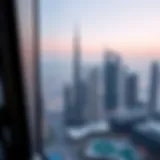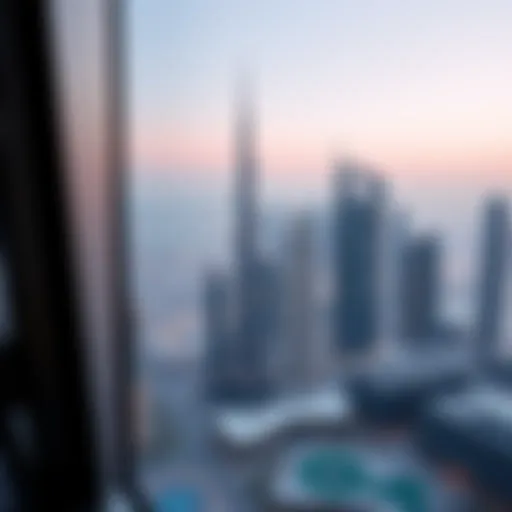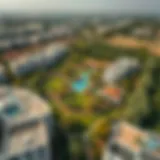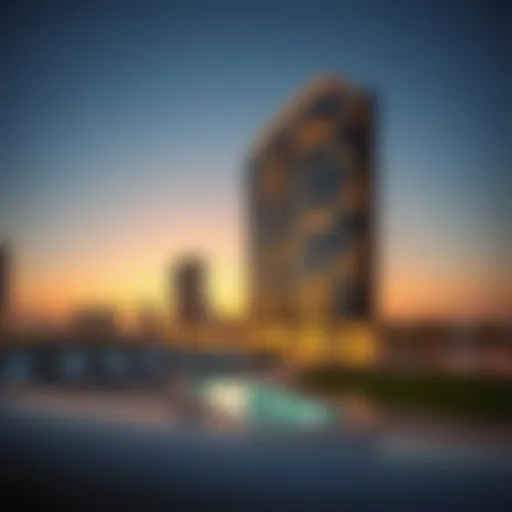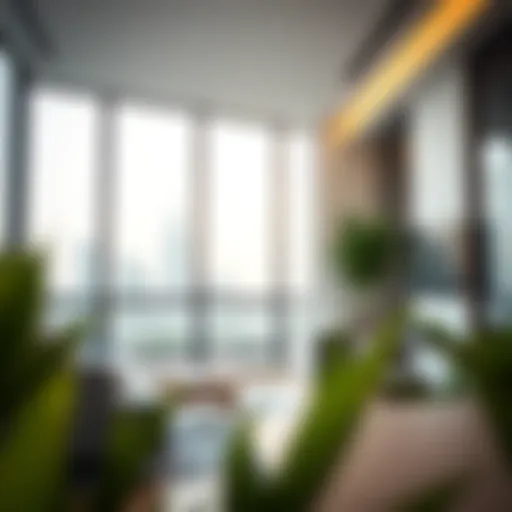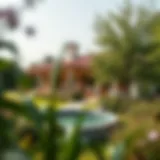Understanding the Metro Dubai: A Comprehensive Overview


Intro
Dubai’s Metro system stands tall as a testament to the city’s rapid growth and ambitious infrastructure initiatives. Designed to mitigate traffic congestion and offer a reliable mode of transport, the Metro has transformed the urban landscape in significant ways. As we immerse ourselves in this comprehensive overview, we'll delve into not just the mechanics of the Metro Dubai, but also its socio-economic implications and the lived experiences of those who traverse its routes. This narrative will highlight the essential stations, user accessibility, and how the Metro has inadvertently fueled real estate trends, effectively shaping the living dynamics within this vibrant metropolis.
Market Trends and Insights
Current Market Analysis
The Metro became operational in 2009, and the ripple effects on Dubai’s real estate landscape have been nothing short of monumental. As stations opened, certain areas witnessed a surge in property values. Locations near the Metro have become prime real estate, enticing investors and buyers alike. The ease of commuting has expanded the appeal of communities that might have once been seen as too far from the city center. Properties in areas like Dubai Marina and Jumeirah Lakes Towers have seen values soar, showcasing the interconnectedness of transportation and urban living.
Much of the recent analysis indicates that access to public transport is pivotal in shaping buyer preferences. Areas like Al Quoz and Deira have also become sought-after locations due to their proximity to Metro stations, marking a shift in traditional preferences.
Historical Trends and Future Predictions
Over the years, several patterns have emerged in terms of property investments around Metro lines. In the past decade, historical data indicates a correlation between Metro station openings and increased property transactions. For instance, in 2009, when the initial phases launched, property prices near the stations grew by approximately 20% within the first year alone.
Looking ahead, there are ambitious plans to further expand the network. The current expansions, projected to complete by 2025, will connect more communities, enhancing accessibility and, undoubtedly, altering market dynamics once more. Investors are already eyeing these upcoming segments, predicting that a ripple effect similar to the past will unfold.
"The symbiotic relationship between public transportation access and property values reshapes not just neighborhoods, but the very fabric of urban life in Dubai."
Property Listings and Comparisons
Luxury Properties Overview
Within the realm of luxury, properties near the Metro are redefining opulence and accessibility. High-profile developments like the One Za'abeel and Burj Al Arab have become not just status symbols but also strategically located havens for those craving convenience. Many of these luxury properties offer exclusive access to the Metro, providing an effortless commuting experience.
Affordable Housing Options
On the other end of the spectrum, there’s a burgeoning market for affordable housing that still enjoys the perks of Metro access. Developments like Dubai South and International City are proving that reasonable prices can coexist with accessibility. These areas are appealing to young professionals and families, creating a diverse urban tapestry.
Collectively, these insights highlight that the Metro is more than just a transport system; it's a driving force in the evolution of Dubai's real estate landscape. As we continue to explore this subject, one thing becomes clear: the Metro has, and will continue to, play a crucial role in shaping the future of urban living in Dubai.
For more information about the Metro Dubai and its impact, consult resources such as Dubai Metro or visit Wikipedia's page on the Dubai Metro.
Stay tuned as we further unveil the intricacies and hidden gems of this fascinating transportation system.
Foreword to Metro Dubai
The Metro Dubai is more than just a transportation system; it's the pulse of a city that has transformed within a short timeframe. With the rapid growth of this cosmopolitan hub, understanding the Metro's role is essential for grasping Dubai’s urban landscape. Its significance extends beyond mere commuting, touching various aspects of daily life and the city’s economic framework.
Overview of the Metro System
Metro Dubai is a marvel of modern engineering. Opening its doors in September 2009, it marked the beginning of a new era in public transportation for the UAE. The system is composed of two main lines: the Red Line and the Green Line. Stretching over 75 kilometers, it boasts 53 stations with modern trains that resemble sleek, futuristic vehicles gliding silently through the city.
What's impressive is that all trains are driverless, making use of state-of-the-art technology to ensure safety and efficiency. Commuters can savor the journey in a clean, air-conditioned environment, far from the hustle and bustle of road traffic. Smart ticketing solutions, such as the NOL card, signify a step towards seamless travel, allowing users to hop on and off without enduring long queues. Notably, each station is equipped with facilities such as retail stores, food outlets, and even art installations, enriching the experience for travelers.
Significance to Dubai’s Urban Development
The establishment of the Metro Dubai emerged as a strategic response to the city's phenomenal growth and increasing population density. In a city where the skyline is humble against the backdrop of endless desert, the Metro plays a vital role in alleviating traffic congestion notorious in urban areas.
Moreover, the Metro isn’t just a transportation system; it’s a catalyst for economic development. Precincts around stations have witnessed a surge in real estate activity, with property values climbing as developers capitalize on the demand linked to accessibility.
"The Metro isn't just about getting from Point A to Point B, it's about enhancing lifestyles and economies in a bustling metropolis."
This access drives investment opportunities within the vicinity, attracting retailers and service providers eager to accommodate the steady flow of commuters. Thus, the Metro has a direct relationship with urban sprawl and zoning, ultimately shaping Dubai’s urban narrative. The intertwining of the Metro and urban planning showcases how transportation infrastructure can redefine city landscapes, supporting sustainable growth in a thriving Emirate.
History and Development
The narrative of Metro Dubai's history is not just about rail systems; it represents the ambitious and rapid urban transformation of an Emirate that has emerged from the sands within a few decades.
Inception of the Metro Project
The seeds of the Metro project were sown in the early 2000s, rooted in Dubai's burgeoning population and economic development. With a soaring number of residents and tourists flocking to the city, the need for an efficient public transportation system became glaringly apparent. This wasn’t merely a logistical decision; it was a visionary leap to meet the demands of a dynamic urban landscape. The official inauguration of the project took place in 2005 under the guidance of the Roads and Transport Authority (RTA), marking a significant turning point in Dubai's infrastructure aspirations. Anchored in an expansive vision, the goal was to create a world-class transport network that connected the dots of a rapidly expanding city, enabling streamlined movement for its inhabitants.
Milestones in Metro Expansion
The journey of the Metro system can be lined with remarkable milestones that reflect Dubai’s forward-thinking ethos. The opening of the Red Line in 2010 was a pivotal moment, serving as a testament to the city's commitment to modern transit solutions. Stretching approximately 52 kilometers, it connected key areas such as Dubai Airport, the Burj Khalifa, and more. Following swiftly, the Green Line launched in September 2011, providing further integration into the core urban areas. Notably, subsequent expansions have included the Route 2020 line, aimed at servicing the Expo 2020 site and beyond, establishing a direct link to futuristic urban developments.
Here are some key milestones:


- 2005: Project inception announced
- 2010: Opening of the Red Line
- 2011: Launch of the Green Line
- 2020: Introduction of the Route 2020 expansion
Challenging Construction Phases
No significant undertaking comes without its hurdles, and the construction phases of the Metro were no exception. Engineers faced several challenges, from the intricacies of tunneling beneath Dubai's bustling streets to navigating existing infrastructure. The rapid expansion of the city required innovative solutions, such as boring under the highly populated areas to minimize disruption and ensure safety. The completion of the Metro system within the timeline presented a unique engineering puzzle that showcased not just technical prowess but an underlying tenacity. The execution of the elevated sections also brought about logistical challenges, requiring careful coordination among contractors and city planners to mitigate any impact on daily life.
The development of Metro Dubai illustrates a clear message: with ambition and innovation, significant hurdles can be overcome, and the skyline of a city can be fundamentally changed for the better.
"In building the Metro, Dubai didn't just create a transportation system; it crafted a lifeline for its evolving urban identity."
Relevant Links
- Dubai Roads and Transport Authority
- Wikipedia - Dubai Metro
- Britannica - Transport in Dubai
- Reddit - Dubai Metro Experiences
- Facebook - Dubai Metro Group
Through this historical lens, the Metro Dubai stands as a exclamation point in the broader dialogue about urban development, signaling that foundational times yield transformative spaces.
Operational Aspects
The operational aspects of Metro Dubai are crucial for understanding how this system integrates into daily life and urban strategy. By evaluating the specifics such as the routes, ticketing, and service frequency, we can grasp the essential role the Metro plays in enhancing commuting experiences and influencing real estate values.
Metro Routes and Stations
The Metro Dubai system features two main lines, the Red and Green Lines, which collectively connect various parts of the city efficiently. The Red Line runs from Rashidiya to UAE Exchange, while the Green Line connects the Dubai Healthcare City to Etisalat. Proposed extensions for both lines are under discussion, reflecting a commitment to continually expand this transport network.
Each station, totaling over 50, boasts its unique design and amenities. For example, the Burj Khalifa/Dubai Mall Station provides direct access to one of the world’s most renowned shopping destinations. Stations are often equipped with art installations and cultural displays, adding an aesthetic quality to the commuting experience. This not only makes travel more pleasant but also draws locals and tourists alike to explore the areas around each station.
Ticketing and Fare Structure
Metro Dubai's ticketing system is noteworthy for its simplicity and accessibility. Using a NOL card, commuters can navigate the fare structure, which is tiered based on distance traveled. Prices range from as little as 3 AED for short distances to around 7.5 AED for longer rides. The system also includes daily and monthly passes that present significant savings for frequent users.
"This user-friendly fare structure encourages people to opt for public transport, supporting Dubai's goals of sustainable urban mobility."
By employing a contactless payment system, riders enjoy a swift entry and exit experience, which is especially beneficial during peak transit hours. Additionally, discounts are available for students, seniors, and people of determination, showcasing the Metro's commitment to inclusivity.
Frequency and Efficiency of Services
Metro Dubai offers an impressive service frequency, with trains running as often as every 2 minutes during peak hours. This high frequency minimizes waiting times and makes it a reliable option for commuters. Moreover, the entire system is designed for maximum efficiency. The utilization of automated trains ensures punctuality and reduces human error, contributing to overall satisfaction among users.
Further, the integration with other modes of transport, such as buses and taxis, enhances the overall connectivity within the city. This seamless interchange not only bolsters the Metro's operational efficiency but also enriches the travel experience for users, fostering a sense of ease and flexibility in navigating Dubai.
In closing, exploring these operational aspects is essential to appreciate how Metro Dubai functions, providing residents and visitors with a robust transportation framework that supports urban growth and enhances overall quality of life.
Impact on Real Estate Market
The impact of Metro Dubai on the real estate market cannot be overstated. The integration of this efficient transportation system has not just transformed how residents move around the city, but it has also reshaped property values, influenced neighborhood development, and opened up new avenues for investment. Understanding this relationship is crucial for investors, realtors, homebuyers, developers, and analysts, as the interplay between transportation and real estate is a significant factor in urban development and property appreciation.
Influence on Property Values
One of the most profound impacts of Metro Dubai is its role in influencing property values. Proximity to metro stations often correlates with increased demand for residential and commercial properties. A study by the Dubai Land Department noted that properties within a one-kilometer radius of metro stations have seen an uptick in value compared to those located further away.
For instance, areas like Al Barsha and Jumeirah Lakes Towers, which house metro stations, have attracted a surge in investment and rental demand. Here are some key influences on property values due to the metro system:
- Convenience: Easy access to metro stations means reduced commuting time, which is a major selling point for potential buyers and renters.
- Enhanced Appeal: Neighborhoods with metro access often present a more attractive lifestyle, with cafes, shops, and entertainment options nearby.
- Long-term Stability: Properties near metro stations tend to withstand market fluctuations better, offering a more stable investment.
Emerging Neighborhoods Around Metro Stations
Metro Dubai has been a catalyst for the emergence of vibrant neighborhoods. As new stations open, they not only provide connectivity but invigorate surrounding areas, often leading to a revitalization that attracts new businesses and residents alike.
For example, the recent addition of stations in Dubai South has spurred new residential and commercial development in what was once largely undeveloped land. As these areas develop, they create a unique ecosystem where new amenities and services flourish. Below are some neighborhoods emerging strongly around metro stations:
- Dubai South: With planned infrastructure for the Dubai Expo 2020, this area is gaining traction through housing developments and commercial hubs.
- Al Rigga: Situated close to the metro, this vibrant area has seen a rise in modern cafes, restaurants, and retail, making it a hotspot for young professionals.
These neighborhoods are not only attractive to local residents but also to expatriates looking for lifestyle options that provide proximity to work and leisure activities.
Investment Opportunities Linked to Metro Access
With the growth of the metro system, numerous investment opportunities arise. Investors should take note of how the metro enhances property values and neighborhood development, as this presents various avenues for potential returns.
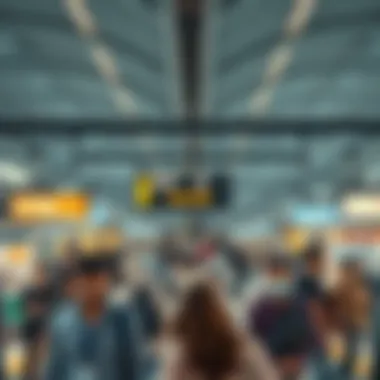

Some viable investment strategies include:
- Buying Residential Properties: Identifying properties near upcoming metro stations can yield high rental returns, particularly as demand for housing grows in these accessible areas.
- Developing Commercial Ventures: Establishing businesses such as retail shops, cafes, or fitness centers near metro stations positions investors for success, capitalizing on increased foot traffic.
- Funding Infrastructure Projects: Collaborating with local government projects related to the metro can lead not only to potential public sector funding but also to increased property appeal in the long run.
User Experience
The user experience of Metro Dubai is crucial for understanding how this rapid transit system functions in the daily lives of its passengers. With efficient transport being a cornerstone of urban life, the Metro aims to provide not just a means of moving from point A to point B, but an overall comfortable and seamless journey. Key elements that play into this include accessibility features, safety measures, and customer service support. Each of these dimensions is designed to enhance the satisfaction of locals and tourists alike, which in turn fosters higher ridership and supports the system's economic viability.
Accessibility Features
Accessibility is paramount in ensuring that Metro Dubai accommodates all users, including those with disabilities and older adults. The design philosophy emphasizes ease of navigation and comfort. Key features include:
- Elevators and Ramps: Strategically placed elevators and ramps allow individuals with mobility challenges to access the platforms effortlessly.
- Tactile Guidance Strips: These are expertly installed along pathways to guide visually impaired passengers through the stations.
- Priority Seating: Reserved seating areas are available for those who require assistance, ensuring they can ride comfortably.
- Audio Announcements and Visual Displays: Clear announcements help inform passengers about upcoming stations and service updates, catering to various sensory needs.
These accessibility features not only promote inclusivity but also reinforce a positive image of the Metro as a user-friendly transportation option.
Safety and Security Measures
Safety and security are intrinsic to a successful public transport system. Metro Dubai takes these aspects seriously by implementing several initiatives that enhance passenger trust:
- Surveillance Systems: The entire Metro system is equipped with advanced surveillance cameras ensuring passengers feel secure throughout their journey.
- On-Site Security Personnel: Trained guards are present in stations and on trains, enabling a quick response to any incidents.
- Emergency Protocols: Clear procedures are laid out for emergencies, and staff is regularly trained on how to assist passengers effectively during such instances.
- Fire Safety Measures: Metro Dubai follows stringent safety protocols, including smoke detectors and fire extinguishers throughout the network to prevent disasters.
The sense of safety not only encourages ridership but also solidifies the community's confidence in the Metro as a reliable mode of transport.
Customer Service and Support
Customer service can make or break a user’s experience, and Metro Dubai actively seeks to assist passengers at every step:
- Information Desks: Well-staffed information desks are strategically located in stations to provide guidance about routes, ticketing, and local amenities.
- Online Support: A comprehensive online platform is available, offering FAQs and live chat options for immediate concerns.
- Feedback Mechanisms: The Metro encourages feedback through surveys and comment boxes, enabling continuous improvement based on passenger experiences.
- Mobile Applications: Their app includes real-time updates, easy access to schedules, and ticket purchasing capabilities, enhancing the overall travel experience.
By prioritizing excellent customer service, Metro Dubai cultivates loyalty and creates a more enjoyable travel environment for all passengers.
Challenges and Criticisms
Understanding the challenges and criticisms surrounding the Metro Dubai system sheds light on the complexities of urban transit in a city as dynamic as Dubai. This section addresses various operational difficulties as well as public sentiment issues that can affect both the perception and functionality of this transit network. Recognizing these challenges can help stakeholders, including investors, realtors, homebuyers, and developers, make informed decisions regarding the implications of the Metro.
Operational Challenges
The operational facets of the Metro system are not without their hurdles. Technical difficulties, such as maintenance and reliability of trains, often lead to disruptions. While the Dubai Metro is praised for its punctuality, there have been instances where technical failures have resulted in service delays. These disruptions can frustrate daily commuters and tarnish the system's reputation.
There are also challenges related to capacity. During peak hours, trains can become crowded, leading to a less-than-ideal commuting experience. This congestion not only affects passenger comfort but can also deter potential users who might prefer the convenience of personal vehicles.
Moreover, the management of safety protocols adds another layer of complexity. Over the years, incidents, albeit rare, raising questions around passenger safety have led to heightened security measures. Though this is important for user confidence, it can also cause delays and inconveniences, occasionally forcing commuters to adjust their schedules.
Key Operational Challenges:
- Technical failures leading to service interruptions
- Overcrowding during peak hours
- Stricter security protocols causing delays
Public Perception Issues
Public perception plays a pivotal role in the success of any public transportation initiative, and the Metro Dubai is no exception. While many appreciate the convenience it provides, there exist lingering doubts among some residents. Skepticism about the system’s reliability can hinder its growth in popularity. If commuters hear about frequent delays or malfunctions, they may hesitate to use the Metro as their daily mode of transport.
Another significant aspect is the image of safety. Although enhancements have been made, the feeling of safety in transit cannot be understated. Any negative news or isolated incidents might amplify worries among potential passengers, leading them to shun public transit in favor of alternate modes of transportation.
Additionally, perceptions regarding cleanliness and maintenance cannot be ignored. While most stations maintain a high standard, any instance of neglect can create a ripple effect, skewing public opinion.
Factors Influencing Public Perception:
- Reports of service reliability issues
- Safety concerns from users
- Cleanliness and maintenance of facilities
"The perception of safety and reliability can be just as critical as the actual service, influencing user trust and ridership rates."
By understanding these challenges and criticisms, stakeholders can not only address immediate operational concerns but also build a more robust public relations strategy that alleviates doubts and enhances user sentiment towards the Metro Dubai system.
Comparative Analysis
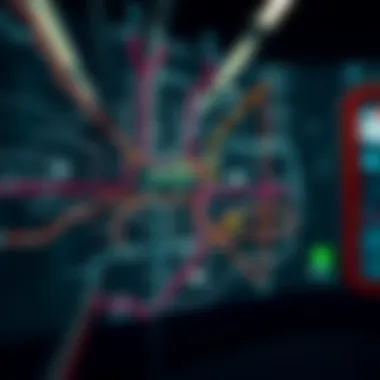
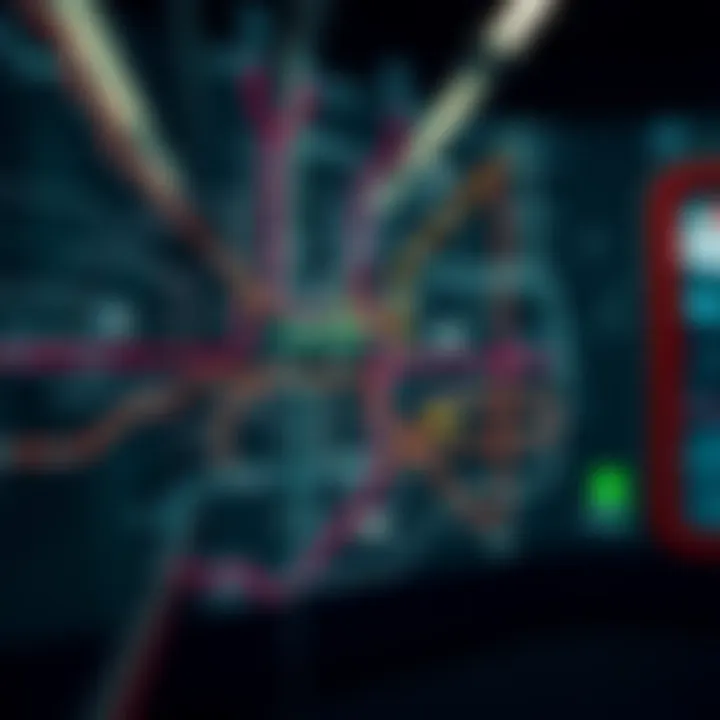
Importance of Comparative Analysis in This Article
When examining an infrastructure project as prominent as Metro Dubai, it becomes essential to situate it within a broader context. Comparative analysis allows us to juxtapose the Metro system with similar transport networks in other major global cities. Through this comparison, we can explore the unique aspects of Metro Dubai, understanding its successes, shortfalls, and lessons that can be drawn from its implementation and operation. This section sheds light on the notable features of various metro systems and identifies potential strategies that could enhance Metro Dubai's service further.
The benefits of conducting a comparative analysis extend beyond simple observation. It provides valuable insights into operational efficiency, user satisfaction, environmental impacts, and economic outcomes. Investors, realtors, and urban developers can glean knowledge about established trends and technological adaptabilities that could guide future decisions regarding urban transit developments. This heightened understanding of global best practices establishes a deeper appreciation of Metro Dubai, not merely as a local entity but as part of an interconnected, international urban transit landscape.
Metro Systems in Global Cities
Diving into the specifics, a range of cities have developed robust metro systems, each tailored to their unique demographic and cultural climates. Take Tokyo, for instance. The Tokyo Metro, known for its punctuality and frequency, effectively accommodates approximately 9 million passengers daily. Contrasting this with New York City, whose subway system offers less frequency but runs 24/7, reveals how operational choices reflect the cities' varying populations and transport needs.
The typical layout in London, highlighted by the iconic London Underground, marries historical infrastructure with modern demands. Its complex maze of lines connects sprawling urban areas, fostering a sense of community among passengers. In comparison, Singapore presents a model of cleanliness and efficiency in its Mass Rapid Transit (MRT) system, integrating technology in ticketing and train operations, which enhances user experiences significantly. The Metro Dubai showcases similarities in its ambitious scope and modern design.
"A metro system is not just a means of transportation; it is a lifeline of urban interaction, shaping the very essence of a city's daily rhythm."
Understanding these global metro systems, their operations, and user engagement strategies provides critical insights into what Metro Dubai could aspire to or critique. Moreover, it illustrates how diverse geographical and cultural backdrops influence the design and success of metro networks.
Lessons Learned from Other Cities
Through comparative analysis, the lessons gleaned from other cities can serve Metro Dubai well. One of the pivotal points is the need for flexibility in operations. Stockholm excels in adapting services based on user demand, adjusting frequencies during peak and off-peak hours, leading to increased customer satisfaction. This approach could be mirrored in Dubai to better align with the dynamic ebb and flow of its populace.
Another noteworthy practice is the integration of technology. Cities like Seoul have embraced innovative solutions such as mobile apps for real-time transit updates, which greatly enhance user experience. Metro Dubai has begun this journey, but there remains significant potential for further digital transformation.
Further lessons surface in terms of stakeholder engagement. In Barcelona, the metro system underwent significant changes after series of public consultations to elicit feedback and drive improvements. Involving the community in decision-making emphasizes transparency and builds trust, traits important for the ongoing evolution of Metro Dubai.
In summary, interconnecting observations from these international systems presents a roadmap for Metro Dubai to refine its operations. By carefully examining what works (or doesn't) elsewhere, the metro can continue to evolve, ensuring it meets the long-term needs of passengers and the urban fabric of Dubai.
Future Growth of Metro Dubai
The future expansion of the Metro Dubai system serves as a pivotal aspect of discussions for urban planning and development, particularly as the city continues to grow at a rapid pace. It plays a crucial role in enhancing connectivity, easing traffic congestion, and promoting sustainability amid increasing urbanization. This expansion is not just a matter of adding more stations; it embodies a broader vision of integrating modern transit solutions within Dubai's continuing journey toward becoming a global hub for diversity and innovation.
Upcoming Expansions and Projects
Metro Dubai is eyeing a host of ambitious expansion projects in the coming years. Some of the most notable include:
- Route 2020: This extension of the Red Line aims to connect the metro to the Expo 2020 site, which is anticipated to boost tourism and increase accessibility to events, drawing in visitors from various parts of the world.
- New Stations: Plans include adding several new stations, particularly in areas like Dubai Marina, Al Furjan, and Dubai Sports City, enabling residents and workers in these burgeoning neighborhoods to tap into metro services more effortlessly.
- Integration with Other Transport Modes: Efforts are underway to better integrate the metro with tram services, buses, and even water taxis, providing seamless transit options for commuters. This kind of coordination is crucial for enhancing the overall public transport experience, making it far more practical for users.
Fact: The current goal is to extend the metro network by over 90 kilometers by 2030, a testament to Dubai's commitment to advancing its urban transport infrastructure.
These expansions not only reflect a need for improved urban transit but also signify an investment in the future. As neighborhoods grow, so does the need for reliable public transport, and the Metro aims to meet this demand head-on.
Technological Advancements and Innovations
As the Metro Dubai eyes the future, technological advancements remain at the forefront of its expansion strategy. Innovations in this field can significantly bolster the operational efficiency of the metro system while enhancing the user experience in several ways:
- Smart Ticketing Systems: The introduction of contactless payment solutions and mobile ticketing is on the horizon, simplifying fare collection and boosting convenience for commuters.
- Real-time Tracking and Monitoring: The incorporation of AI and IoT is set to enhance system management drastically. Real-time data can provide insights into train schedules, maintenance needs, and even passenger volumes, thereby optimizing operations and improving service.
- Sustainability Initiatives: As concerns for the environment grow, Metro Dubai is exploring eco-friendly technologies, like energy-efficient trains and solar-powered stations. Such initiatives underline the importance of aligning urban transport development with environmental responsibility.
By embracing these advancements, Metro Dubai aims to not only improve the commuter experience but also set a benchmark for other cities looking to modernize their transport infrastructure. The focus is on creating a transport network that is not only functional but also smart, sustainable, and seamlessly integrated with the city's broader urban ecosystem.
Investors, realtors, and homebuyers should keep a close eye on these developments, as they herald significant changes that will affect property values, ease of transportation, and the overall living experience in Dubai.
Culmination
Understanding the Metro Dubai system encapsulates the intricate fabric of urban transit and its profound implications for Dubai's landscape. This article serves as a rich exploration of how the Metro not only eases daily commutes but also influences key aspects of life in the city.
Summary of Key Points
Throughout the discourse, we've ventured into various dimensions of the Metro system:
- Historical Context: We traced back its inception, observing the ambitious planning and remarkable execution that marked Dubai's journey into modern transit.
- Operational Insights: The routes, stations, and their efficient operation underscore the seamless connectivity and accessibility that the Metro offers to millions.
- Impact on Real Estate: We outlined how proximity to Metro stations can significantly uplift property values, transforming areas into vibrant neighborhoods.
- User Experience: A closer look was taken at how the Metro prioritizes accessibility, safety, and customer service, reinforcing its position as a reliable transport option.
- Challenges: We acknowledged some operational issues and public perceptions that might color the user experience.
- Future Growth: Upcoming projects hint at further enhancements, driven by advancements in technology and urban planning strategies.
Each of these points illustrates a vital piece of the puzzle that is Metro Dubai, and together they paint a picture of a robust transport infrastructure that meets today’s demands while anticipating tomorrow's trends.
Implications for Residents and Investors
The relationship between the Metro and the communities surrounding it extends far beyond merely commuting. For residents, it promises enhanced mobility; for investors, it signals opportunities.
Residents find more than just a mode of transport; they discover an avenue to more accessible lifestyles. Areas adjacent to Metro stations often thrive from increased foot traffic, evolving from quiet neighborhoods into bustling hubs. This vibrancy can translate to a better quality of life, with shops, cafes, and recreational spots sprouting up, all catering to the needs of locals and commuters alike.
For investors and developers, the Metro’s expansion and growth present lucrative prospects. Data suggests that properties within close proximity to Metro stations often appreciate at a faster rate. As more developments arise, early investors may reap significant returns, not to mention the importance of identifying emerging neighborhoods that will benefit from Metro access in the future.
The urban transformation inspired by the Metro Dubai not only benefits those who live in the area but also attracts new residents and businesses, perpetuating a cycle of growth.
In essence, as we conclude our exploration of the Metro Dubai, it is clear that the implications of this system are vast and lie at the heart of the city’s ever-evolving narrative. Investors, realtors, and potential homebuyers would do well to consider the Metro's influence on property values and lifestyle dynamics, as it continues to shape and redefine the urban experience in Dubai.






